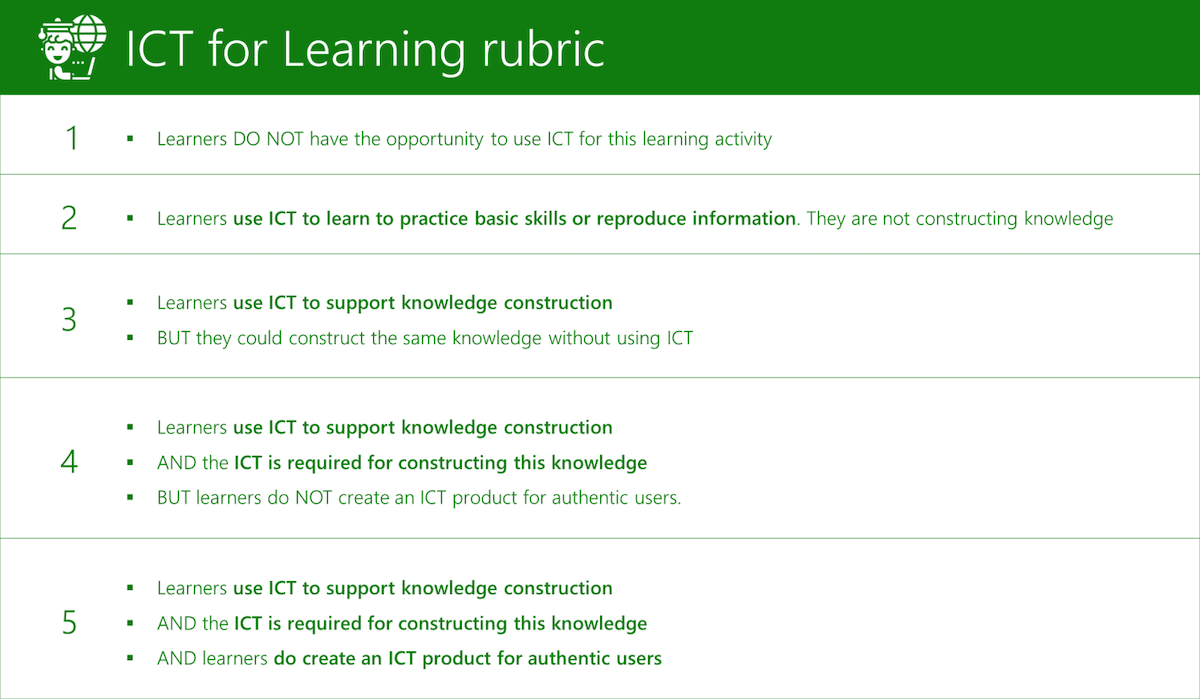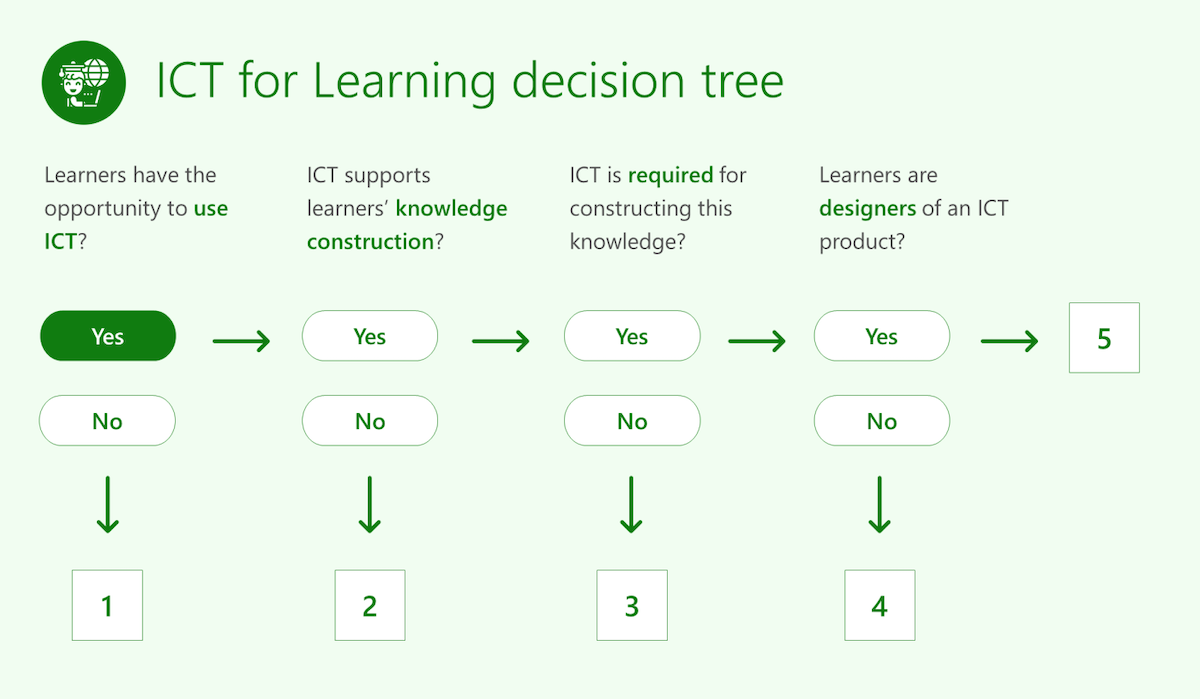Design learning experience with the ICT for learning rubric
The ICT for Learning rubric examines whether learners use ICT in activities. In stronger activities, the use of ICT supports knowledge construction. In the strongest activities, learners use ICT to design knowledge-based products.
The ICT for Learning rubric captures the big ideas of ICT for learning and is a useful framework when designing activities to develop learners’ ICT skills. The levels of ICT for learning (one to five) are:

Go to Rubric – Use of ICT for Learning for an accessible version of the rubric.
The ICT for Learning decision tree is a visual way of representing the big ideas in the rubric. It poses four questions educators must answer when designing activities that use ICT for learning:
- Do learners have the opportunity to use ICT?
- Does the use of ICT support learners' knowledge construction?
- Is ICT required for constructing this knowledge?
- Are learners designers of an ICT product?

Go to Decision Tree – Use of ICT for Learning for an accessible version of the decision tree.
Do learners have the opportunity to use ICT?
Learners have the opportunity to use ICT if they must use it or have the choice to use it to complete an activity. ICT use occurs when learners use ICT directly to complete all or part of the learning activity. Learners must have control over the ICT use themselves.
While ICT in teaching is a powerful tool for communicating complex ideas to learners, it’s irrelevant to this rubric which focuses on learners’ use of ICT.
In the following scenarios, learners don't have the opportunity to use ICT:
- Learners completing a math learning activity using worksheets that the educator has printed
- Learners studying cell replication by watching the educator play a virtual simulation of the process
- The educator using Microsoft Word to make suggestions and track changes to a learner's writing
In the following scenarios, learners have the opportunity to use ICT:
- Learners completing a math learning activity using Excel
- Learners studying cell replication using a software simulation to explore the process
- Learners using Microsoft Word to edit their writing, tracking their changes as they go
Does the ICT use support learners' knowledge construction?
Knowledge construction occurs when learners generate ideas and understandings that are new to them through:
- Interpretation
- Analysis
- Synthesis
- Evaluation
Learners use of ICT may support knowledge construction either directly or indirectly. For example:
- When learners use a computer to analyze scientific information, ICT supports knowledge construction directly
- When learners search for terms related to current events on Twitter and then analyze people's responses offline, ICT indirectly supports knowledge construction. The information they find on Twitter supports their analysis, so their ICT use supports knowledge construction.
The knowledge construction supported by ICT must focus on the learning goals of the activity. Learning to use ICT does not qualify. For example, learners might learn about PowerPoint as they create a presentation for history class. However, to support knowledge construction, the use of PowerPoint must help learners deepen their interpretation, analysis, synthesis, or evaluation of historical ideas.
Evaluation of internet resources related to the learning goals is also knowledge construction. Activities designed to help learners become intelligent, ethical users of the internet rather than passive consumers of the information support knowledge construction. For example, learners might find several sources on a topic and evaluate their credibility before they select which information to rely on.
In the following scenarios, the ICT use doesn’t support knowledge construction:
- Learners using Excel to add numbers together
- Learners watching a video about how stars are formed
- Learners using Microsoft Whiteboard to make a list of the characters in a novel they’re reading in literature class
- Learners playing an Xbox driving game
- Learners using Microsoft Word to type an essay they have written
- Learners using a collage app to create a composite image of art works by an artist of their choice
- Learners who have already studied triangles using a graphing calculator to create triangles by entering angle numbers that add up to 180 degrees
In the following scenarios, the use of ICT supports knowledge construction:
- Learners using Excel to analyze results of an experiment
- Learners using a computer-based simulation to investigate how stars are formed
- Learners using Microsoft Whiteboard to create interconnected plots and character diagrams for a novel they’re reading in literature class
- Learners using an Xbox driving game to research and publish the consequences of texting while driving
- Learners writing an essay on a computer using Microsoft Word to organize and synthesize their ideas in writing
- Learners using a collage app to create a composite image that reflects the style and influences of an artist of their choice
- Learners who haven’t studied triangles experimenting with a graphing calculator by entering angle degrees and hypothesizing the total number of degrees in a triangle
Is ICT required for constructing this knowledge?
ICT is required for knowledge construction when learners complete knowledge construction activities which would be impossible or impractical without the use of ICT. For example, learners may communicate with peers in another country/region over a period of two weeks to research the impact of a recent drought on their community. Mailing physical letters would be impractical in this short time. In this case, email enables learners to construct knowledge that they wouldn’t be able to do without ICT. The use of email is therefore required for constructing this knowledge.
Learners may complete many activities that require knowledge construction without ICT. For example, learners may find information about the beaks of a variety of bird species with different diets and categorize different types of beaks. If learners use the internet for this activity, they’re constructing knowledge; but they don’t have to use ICT. They would be able to achieve the same learning goals without ICT by using printed books in a library.
In the following scenarios, learners don't need to use ICT to construct knowledge:
- Learners reading the local newspaper online to research a current event and analyze three stories they find
- Learners using Excel to compute totals that they'll use to analyze their data
In the following scenarios, learners need ICT to construct knowledge:
- Learners using the internet to find newspaper articles about a current event from three different countries/regions and analyzing how perspectives are similar or different
- Learners using a computer-based simulation to investigate how stars are formed
Are learners designers of an ICT product?
Learners are designers of ICT products when they create ICT products others may use. For example, if learners record a podcast and post it on the internet, they’re designing an ICT product. The product lasts beyond the learning activity and an outside audience may use it.
When learners act as designers, ICT is supporting their real-world problem solving and innovation. Learners must have an authentic audience in mind, such as a community that needs the information or younger children who are studying a concept. In their design, learners must attend to the needs and preferences of that audience. Ideally—but not necessarily— the intended audience uses the product. Learners who create a product with no particular audience in mind don’t qualify as designers.
In the following scenarios, learners aren't designers of an ICT product:
- Learners in a computer programming class creating a smartphone app that causes the phone to vibrate whenever the user takes a photo
- Learners using music editing software to create songs about dinosaurs that they'll post on the internet for general access
- Learners creating videos of their own interviews with local community members to submit to the educator
- Learners using the internet to research local food producers and write a report of their findings to submit to the educator
In the following scenarios, learners are designers of an ICT product:
- Learning in a computer programming class designing a smartphone app that may help senior citizens in their daily lives
- Learners using music editing software to create songs to educate a children's natural history museum visitors about dinosaurs
- Learners creating videos of their own interviews with community members that will air on a local television channel program about "our community"
- Learners using the internet to research and communicate with local food producers and then developing an app to help families in their community make more local choices when buying their food
Now, practice coding one of the anchor lessons in the 21CLD OneNote notebook by doing the following:
- Review the Guerilla Marketing Campaign learning activity page.
- Consult either the ICT for learning rubric or decision tree and code the lesson
- If working with colleagues during this module, discuss your findings
- Compare your analysis with Becky's explanation in the following video: